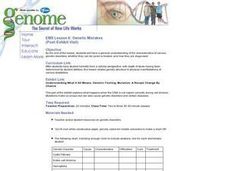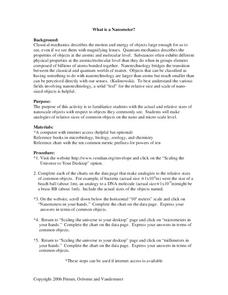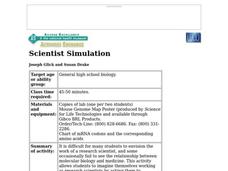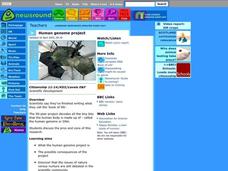Curated OER
Genetic Mistakes
High schoolers explore genetic disorders. They examine the genetic structure to physicial manifestations of various disabilities. Using internet sources, students analyze the characteristics of genetic disorders, whether they can be...
Curated OER
What is a Nanometer?
Students develop a concept of the relative size of objects in the nanoscale. They complete an internet assignment using the website,"Scaling the Universe to Your Desktop". Using analogies to common objects they get an appreciation for...
Curated OER
A View of the Cell
In this cell worksheet, learners will match 13 vocabulary words relating to cells to the correct definition. The cell vocabulary words cover all the parts of the cell plus eukaryotes, and prokaryotes.
Curated OER
The Human Geonome Project Structured Controversy
Students debate government funding of the Human Genome Project. In this ethics lesson, students use the stuctured controversy framework to research the opposing viewpoints regarding project funding.
Curated OER
X or Y- Does it Make a Difference?
Students examine the X and Y chromosomes. In this research lesson plan, students use the 5E lesson plan model as they read articles about human chromosomes then discuss their findings and opinions.
Curated OER
Don't Wait, Just Propagate
Pupils explore the process of growing plants from seed. In this propagation lesson, students examine methods of propagation and determine how to rapidly propagate plant species. Pupils listen to a lecture informing them on the topic and...
Curated OER
Stem Cells
For this stem cells worksheet, students answer multiple choice questions about research found in stem cells. Students complete 5 questions total.
Curated OER
Chloroplasts
Students study chloroplasts, their structure and evolution. In this photosynthesis instructional activity students experiment with polarized light and the production of chlorophyll.
Curated OER
The Euglena
In this euglena worksheet, learners read information about these unicellular organisms. Students then color in the different structures of the euglena on a diagram. Learners complete 10 short answer questions.
Curated OER
Extremophiles- Non-Fiction Reading Comprehension
In this extremophiles non-fiction reading worksheet, students read a two page selection that describes the organisms known as extremophiles. They answer 10 questions based on the selection which include true or false, short answer, and...
Curated OER
Paramecium
In this paramecium worksheet, learners sharpen their science skills as they color the parts of a paramecium according to the instructions and then respond to 15 analysis questions.
Curated OER
Cute Calves of Just Tasty Steaks
Students examine the state of agriculture. In this animal husbandry lesson, students visit selected Web sites to research data on people's changing diets, farming practices, and animal health care.
Curated OER
Scientist Simulation
Young scholars imagine themselves working as research scientists completing the end-steps of a molecular research project and interpreting the data. They compare the gene sequences of normal and abnormal mice and evaluate the protein...
Curated OER
Ladders of Life
Students explore the field of genetics. They examine four basic traits. Students demonstrate their knowledge of phenotype and genotype by charting their personal traits. Students compelte a Meiosis chart. From the chart results,...
Curated OER
Protoplast Production (Plant Cells Without Walls)
Students explore the spherical protoplasts of plants. Students observe that plant cells have a plasma membrane in addition to the cell wall. Students plasma membranes, solutes and organelles.
Curated OER
The Meaning of Genetic Variation
Students investigate variation in the beta globin gene by identifying base changes that do and do not alter function, and by using several Internet-based resources to consider the significance in different environments of the base...
Curated OER
CONSTRUCTION OF A HEMOGLOBIN GENE
Learners use research to see how eight pairs of triplets are equivalent to part of a gene and control a part of heredity. They also understand how red blood corpuscles manufacture normal hemoglobin.
Curated OER
The Electrophoresis of Human Hemoglobin
Students analyze different types of hemoglobin. They use the technique of agarose gel electrophoresis to separate human hemoglobin molecules according to their electrical charge, size, and/or shape. Students relate the migration of...
Curated OER
RFLP Paternity Testing: A Simulation
Students use simulated autorads to discover the principle utilized to determine paternity.
Curated OER
What Happens When A Cell Divides?
Students investigate the cycle of mitosis. In this biology lesson, students discuss the different stages of mitosis through cell reproduction. They further their investigation through laboratory analysis.
Curated OER
Molecular Evolution in Plants
Pupils are using a paper chromatography study that is suitable for introductory biology. The absorption spectra studies and gel electrophoresis studies are appropriate for students who have complete both introductory biology and...
Curated OER
The Effects of Ultra-Violet Light on Yeast
Pupils work in small groups collecting and analyzing data as they learn how to best grow yeast. This lesson plan allows students to conduct several student-created experiments as they continually generate questions and hypotheses. ...
Curated OER
Human genome project
High schoolers research writings on "the book of life." Students research the human genome project. High schoolers discover the issues of nature versus nurture are still hashed over in the scientific community.
Curated OER
Genetic Disorders
Seventh graders discuss traits, traits that are inherited and how genes and chromosomes carry the code for traits. They research genetic disorders and their link to chromosome abnormalites and write a report on their findings. which...























